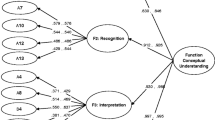Abstract
This paper describes five growth points in linking representations of function developed from a study of secondary school learners. Framed within the cognitivist perspective and process-object conception of function, the growth points were identified and described based on linear and quadratic function tasks learners can do and their strategies and approaches on these tasks. A cross-sectional study was then made to investigate for a typical trajectory of the growth points. The tasks were fielded to 444 Year 8, 9, and 10 students, first at the start of the school year and then 5 months later. The framework of growth points, and their resonance with similar research elsewhere, offer a research-based framework that can serve as an analytic tool for describing understanding, assessing learning and for pedagogy.






Similar content being viewed by others
References
Biggs, J. B., & Collis, K. F. (1982). Evaluating the quality of learning: The SOLO taxonomy. New York, NY: Academic.
Breidenbach, D., Dubinsky, E., Hawks, J., & Nichols, D. (1992). Development of the process conception of mathematics. Educational Studies in Mathematics, 23, 247–285.
Cottrill, J., Dubinksy, E., Nichols, D., Schwingendorf, K., Thomas, K., & Vidakovic, D. (1996). Understanding the limit concept: Beginning with a coordinated process schema. The Journal of Mathematical Behavior, 15(2), 167–192.
DeMarois, P., & Tall, D. (1996). Facets and layers of the function concept. Proceedings of PME, 20(2), 297–304.
Dubinsky, E., & Wilson, R. (2013). High school students’ understanding of the function concept. The Journal of Mathematical Behavior, 32(1), 83–101. doi:10.1016/j.jmathb.2012.12.001.
Duval, R. (2006). A cognitive analysis of problems of comprehension in a learning of mathematics. Educational Studies in Mathematics, 61, 103–131.
Even, R. (1998). Factors involved in linking representations. Journal of Mathematical Behavior, 17(1), 105–121.
Howson, G. (1991). National curricula in mathematics. Avon, UK: The Bath Press.
Kalchman, M., Moss, J., & Case, R. (2001). Psychological models for the development of mathematical understanding: Rational numbers and functions. In S. Carver & D. Klahr (Eds.), Cognition and instruction: Twenty-five years of progress (pp. 1–38). Mahwah, NJ: Lawrence Erlbaum Associates.
Kaput, J. (1989). Linking representations in the symbol systems of algebra. In S. Wagner & C. Kieran (Eds.), Research issues in the learning and teaching of algebra (pp. 167–194). Reston, VA: NCTM.
Kerslake, D. (1982). Graphs. In K. M. Hart (Ed.), Children’s understanding of mathematics (pp. 120–136). London: John Murray.
Leinhardt, G., Zaslavsky, O., & Stein, M. K. (1990). Functions, graphs, and graphing: Tasks, learning and teaching. Review of Educational Research, 60(1), 1–64.
Monk, G. S. (1994). Understanding of functions in calculus courses. Humanistic Mathematics Network Journal (9), 21–27.
Oehrtman, M. C., Carlson, M. P., & Thompson, P. W. (2008). Foundational reasoning abilities that promote coherence in students’ understandings of function. In M. P. Carlson & C. Rasmussen (Eds.), Making the connection: Research and practice in undergraduate mathematics (pp. 27–42). Washington D.C.: MAA.
Pirie, S. E. B., & Kieren, T. E. (1994). Growth in mathematical understanding: How can we characterise it and how can we represent it? Educational Studies in Mathematics, 26, 165–190.
Radford, L. (2013). Three key concepts of the theory of objectification. Journal for Research in Mathematics Education, 2(1), 7–44.
Ronda, E. (2009). Growth points in students’ developing understanding of function in equation form. Mathematics Education Research Journal, 21(1), 31–53.
Schwarz, B., & Dreyfus, T. (1995). New actions upon old objects: A new ontological perspectives on functions. Educational Studies in Mathematics, 29, 259–291.
Sfard, A. (1991). On the dual nature of mathematical conceptions: Reflections on processes and objects as different sides of the same coin. Educational Studies in Mathematics, 22, 1–36.
Sfard, A. (2008). Thinking as communication. Cambridge: Cambridge University Press.
Sfard, A., & Linchevski, L. (1994). The gains and pitfalls of reification. Educational Studies in Mathematics, 26, 191–228.
Sierpinska, A. (1992). On understanding the notion of function. In G. Harel & E. Dubinsky (Eds.), The concept of function: Aspects of epistemology and pedagogy (MAA Notes) (pp. 25–58). Washington DC: Mathematical Association of America.
Slavit, D. (1994). The effect of graphing calculators on students conception of function. Paper presented at the annual meeting of the American Educational Research Association, New Orleans, LA.
Slavit, D. (1997). An alternate route to the reification of function. Educational Studies in Mathematics, 33, 259–281.
Thomas, H. L. (1971). The concept of function. Paper presented at the Annual Meetiing of the American Educational Research Association, New York City.
Thompson, P. (1994). Students, functions and the undergraduate curriculum. In E. Dubinsky, A. Schoenfeld, & J. Kaput (Eds.), Research in collegiate mathematics education (pp. 21–44). Providence, RI: American Mathematical Society.
Wilmot, D., Schoenfeld, A., Wilson, M., Champney, D., & Zahner, W. (2011). Validating a learning progression in mathematical functions for college readiness. Mathematical Thinking and Learning, 13(4), 259–291. doi:10.1080/10986065.2011.608344.
Acknowledgment
This paper is based on the author’s dissertation under the supervision of Doug Clarke. Many thanks to Jill Adler for her input through the development and review process.
Author information
Authors and Affiliations
Corresponding author
Rights and permissions
About this article
Cite this article
Ronda, E. Growth points in linking representations of function: a research-based framework. Educ Stud Math 90, 303–319 (2015). https://doi.org/10.1007/s10649-015-9631-1
Published:
Issue Date:
DOI: https://doi.org/10.1007/s10649-015-9631-1




